Physical Address
304 North Cardinal St.
Dorchester Center, MA 02124
Pathologists routinely evaluate endometrial biopsies, which account for at least 20% of gynecologic specimens requiring pathology consultation. The majority of endometrial biopsies are performed for abnormal uterine bleeding (AUB) and questions that are posed in each situation requiring biopsy and the clinical information required vary for each individual case ( Table 16.1 ). For adolescent women, AUB will most likely be transient but can at times be severe, often because of the presence of underlying bleeding disorders. For women in the third and fourth decades, a range of disorders must be excluded. Bleeding on contraceptives, if transient, may not require sampling. However, persistent bleeding or situations in which the status of the endometrium must be evaluated, such as during fertility evaluations or to rule out hyperplasia in the setting of polycystic ovarian disease or disturbances in luteal phase, warrant sampling. The fifth decade witnesses the approach of menopause when abnormal bleeding heralds the cessation of ovulation. In the six and seventh decades, the questions shift to causes of bleeding in the patient on hormonal replacement therapy, or if the patient is not on hormones, other causes of unexpected bleeding, particularly the possibility of a neoplastic process. In all age groups, the clinical and laboratory management of abnormal bleeding is designed to determine whether the bleeding is a function of a structural disturbance (histologically abnormal disturbance, such as endometrial polyps, submucosal leiomyomata, inflammatory/infectious, or unopposed estrogen effect) or a functional disorder devoid of a structural or histologic anomaly ( Fig. 16.1 ). Superimposed on this test matrix of ultrasound, hysteroscopy, biopsy, and histologic evaluation is the not-infrequent urgency imposed by unusually heavy hypermenorrhea (menorrhagia) or both heavy and frequent (menometrorrhagia) bleeding ( Table 16.2 ).
| Age (Years) | Causes (In Order of Decreasing Frequency) |
|---|---|
| Prepubertal | Precocious puberty (hypothalamic, pituitary, ovarian) |
| Adolescence |
|
| Third and fourth decades |
|
| Fifth decade |
|
| Sixth decade |
|
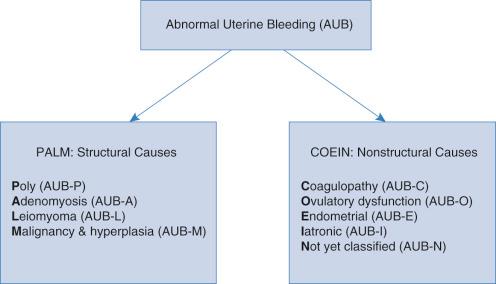
| Term | Description |
|---|---|
| Oligomenorrhea | Bleeding at intervals greater than 35 days |
| Polymenorrhea | Bleeding at intervals less than 21 days |
| Hypermenorrhea (menorrhagia) | Excessive flow or bleeding with normal intervals |
| Metrorrhagia | Bleeding between menses |
| Menometrorrhagia | Excessive flow or duration with periods and between periods |
| Withdrawal bleeding | Bleeding following the withdrawal of hormones |
Although not specified as a cause of abnormal bleeding, concurrent pregnancy, including ectopic gestations, may be reported as “abnormal bleeding” in unsuspecting women of reproductive age or interpreted as such by the caregiver. Thus, where appropriate, pregnancy must be excluded.
Several books, chapters, and reviews are available on the interpretation of benign endometrium and have clarified, or introduced improvements, in the original scheme put forth by Noyes et al. Nevertheless, the wide range of alterations seen in the endometrium during reproductive and menopausal years poses a challenge to many practitioners. This chapter addresses a framework on which to superimpose the histologic images that are encountered when reviewing the endometrial biopsy. The goal of this chapter is to integrate a range of overlapping templates, including age and disturbances that are peculiar to age with morphology and differential diagnosis, and ultimately, the clinical scenarios of presentation on one end and management on the other.
The endometrial cycle ( Table 16.3 ) entails the interplay of four participants: the hypothalamus, pituitary, ovarian cortex, and endometrium. These regulators of menstrual cycle interact to direct the two major phases of the ovulatory cycle, termed follicular and luteal phases, based on ovarian function or their synonyms, proliferative-, and secretory-based endometrial morphology ( Fig. 16.2 ). Gonadotropin-releasing hormone (GnRH) is released in pulsatile fashion from the arcuate nuclei of the hypothalamus and orchestrates the release of follicle-stimulating hormone (FSH) and luteinizing hormone (LH) from the pituitary. Regulation of these hormones is dependent (positively) on the GnRH and (negatively) on the production of estrogens and progesterone by the follicle and corpus luteum, respectively, that feedback on the pituitary.
| Category | Patterns (Corresponding Figures) |
|---|---|
| Menstrual (ovulatory) endometrium |
|
| Late menstrual (ovulatory) endometrium |
|
| Proliferative endometrium | Tubular glands, mitoses (see Fig. 16.6A to D ) |
| 16-day endometrium | Tubular glands, mitoses, scattered subnuclear vacuoles (see Fig. 16.7B ) |
| Secretory endometrium |
|
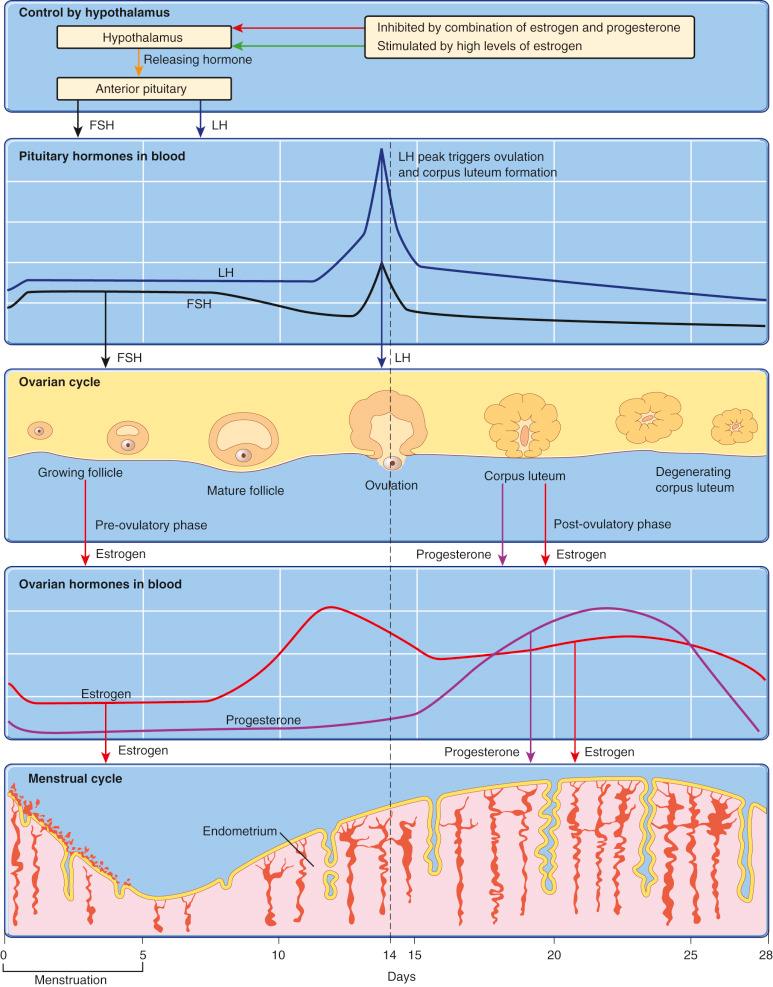
FSH increases prior to menstruation and initiates the process of recruitment of several follicles during stromal breakdown and regeneration. Subsequently, a dominant follicle emerges and is self-sustaining at the expense of its neighbors, converting androgen to estrogen with the aid of LH, maximizing its response to FSH by the production of activins while suppressing FSH by inhibins and the estrogen feedback loop. Ultimately this process confers the dominant follicle selective advantage over the now regressing surrounding follicles. Estradiol production by this follicle maintains proliferation and growth of the endometrium in the first 2 weeks of the cycle.
The midcycle LH surge immediately follows the peak of estradiol levels, resulting in follicle rupture and release of the ovum. The LH surge is followed by an increase in progesterone production by the now luteinized granulosa cells. The latter marks the transition from follicle to corpus luteum and initiates the vacuole phase of early secretory endometrium. Progesterone levels rise rapidly and remain elevated for approximately 14 days, terminating endometrial gland proliferation and promoting secretory conversion and predecidual changes in the latter half of the luteal phase. Estrogen secretion continues during this phase of the cycle, albeit at lower levels.
The onset of menstruation occurs if fertilization does not take place. The corpus luteum begins to regress and the highly vascular predecidualized endometrium with its complex secretory gland architecture rapidly disintegrates over an average of 5 days. This process of dissolution levels off at the basalis, and the onset of the next cycle is characterized by restoration of an intact surface epithelium by migration from the gland crypts and resumption of the integrity of the endometrial stroma. The cycle begins anew.
Fewer than 15% of all women have a “prototypical” menstrual cycle lasting 28 days. Most fall between 24 and 35 days, and 20% of women will at some time experience an irregular cycle. Durations of flow may range from 2 to 7 days, although most are within 4 to 6 days. Blood loss should be less than 30 mL. Thus, cycles with durations of flow of less than 2 or greater than 7 days with blood loss exceeding 80 mL are abnormal. Anovulatory cycles are most common before age 20 and after age 40.
Cyclic endometrium can be subdivided into seven phases based on morphologic appearance; these are summarized in Table 16.3 . These include (1) menstrual phase composed of scheduled (ovulatory) breakdown, (2) early proliferative phase with residual stromal breakdown leftover from the prior menstrual cycle that was just completed, (3) mid to late proliferative phase, (4) 16-day endometrium, (5) the vacuole phase of early secretory endometrium, (6) the secretory exhausted phase, and (7) the predecidual phase. Cycle phase assignment is often described in terms of an idealized 28-day cycle in which day 1 corresponds to the first day of clinical menses. Women whose regular cycle length differs from this 28-day model typically have variations in length of the preovulatory interval. Postovulatory phases (postovulatory days [PODs] 17 to 28 in an idealized cycle), however, are quite consistent in duration even among women with differing overall cycle lengths.
There are four reasons for assigning as precise a date as possible to an endometrial biopsy:
The need to establish that ovulation has or has not taken place.
To determine if the assigned date falls within the expected range based on the patient's last menstrual period. This requires cooperation of both the clinician and the pathologist in determining whether a disturbance in the luteal phase has occurred.
To determine if a morphologically visible maturation disturbance exists, such as dyssynchronous maturation of endometrial glands in relation to the stroma.
To become accustomed to small differences in morphology of benign endometrial changes. An appreciation of such nuances may facilitate the recognition of subtle neoplastic processes.
Menstrual phase is morphologically defined by collapse of the stroma and shedding of the functionalis. Lytic enzymes are confined within lysosomes in the early part of the luteal phase, maintained by progesterone. Release of matrix metalloproteinases (e.g., collagenases, gelatinases, stromelysins) occurs with the drop in progestin and is accompanied by activation of clotting followed by fibrinolysis. The earliest feature of this process is condensation of predecidual cells into discrete aggregates or cordlike arrangements admixed with blood and inflammatory cells ( Fig. 16.3A ). Subsequently, a pattern of “scheduled breakdown” ensues, with coordinate collapse of the functionalis, sheets of neutrophils, and the characteristic plump aggregates of necrotic predecidua. Included in this detritus of ovulation are exhausted secretory glands that range from large, irregularly shaped glands with slightly stratified nuclei (a consequence of epithelial collapse and nuclear condensation) to single-cell layered epithelium with a thin or delicate appearance ( Fig. 16.3B ). The presence of predecidual stromal aggregates or exhausted glands typifies ovulatory breakdown and, when encountered, this pattern of scheduled (diffuse) breakdown with acute inflammatory debris most commonly signifies that ovulation has occurred. At day 3 of the menses, the diagnosis of ovulation can still be made provided sufficient secretory exhausted glands are still present ( Fig. 16.3C ). Following this, the remainder of the breakdown occurs in the lower functionalis and the diagnosis of ovulation cannot be confirmed on histologic grounds. The diagnosis rendered for these changes is “menstrual (ovulatory) endometrium.”
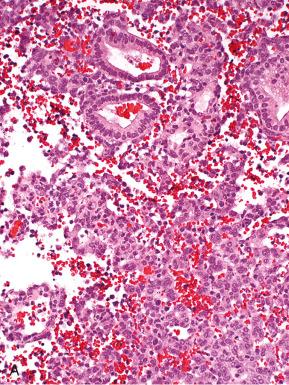
Two variations in menstrual endometrium have been reported in the past. The first is irregular shedding. In this pattern, fragments of intact predecidualized endometrium coexist with early proliferative-pattern endometrium. The explanation for this picture is persistent corpus luteum, leading to a greater range of findings in which features of early breakdown (predecidualized fragments) coexist with later regenerative (tubular glands) components ( Fig. 16.3D and E ). The second variation is membranous dysmenorrhea, consisting of cohesive sheets of predecidualized endometrium with scarce glands, alternating with conventional disaggregated endometrium ( Fig. 16.3F ). This pattern was anecdotally associated with dysmenorrhea in some instances, hence the term.
Certain diagnostic pitfalls may be encountered in association with real or perceived menstrual endometrium. The first is the misdiagnosis of menstrual endometrium as endometrial adenocarcinoma, which may be simulated by the collapse of glands and the associated necrotic predecidua ( Fig. 16.4A ). The second pitfall is the reverse—small disaggregated fragments of adenocarcinoma that may simulate stromal breakdown ( Fig. 16.4B ). Less serious pitfalls are other patterns of breakdown that may be associated with a variety of disturbances that do not signify ovulation. These are summarized in Table 16.4 and illustrated elsewhere in this chapter.
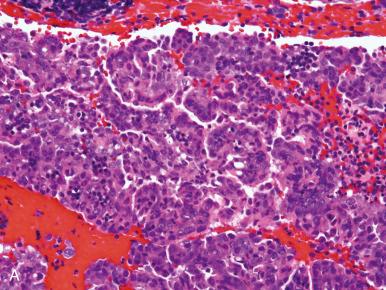
| Cause | Pattern (Corresponding Figure) |
|---|---|
| Ovulatory | Exhausted glands, diffuse breakdown, necrotic predecidua, acute inflammation (see Fig. 16.3A and B ) |
| Late menstrual | Tubular glands, variable vacuoles, rare mitoses, surface breakdown, poor surface epithelial-stromal cohesion (see Fig. 16.5A to C ) |
| Replacement therapy | Tubular glands, spindled stroma, variable stromal cohesion (see Fig. 16.37A ) |
| Anovulation (persistent follicle) | Patchy breakdown, cystic, irregular glands, fibrin thrombi, blue stromal aggregates, gland karyorrhexis (see Fig. 16.15C to E ) |
| Mid-cycle (follicle dysfunction) a | Intact functionalis, tubular glands, diffuse breakdown (see Fig. 16.16A to D ) |
| Unknown b | Stromal breakdown only, minimal glands, similar to late menstrual |
| Chronic endometritis | Lymphoplasmacytic infiltrates, intraglandular exudates (see Fig. 16.21 ) |
| Endometrial polyp | Surface breakdown |
| Post-pregnancy | Similar to late menstrual, necrotic decidua (decidual cast) |
| Post-progestin therapy | Similar to post-pregnancy (see Fig. 16.36A to C ) |
a A diagnosis of dysfunctional uterine bleeding is permitted once any pathology has been excluded.
b In the absence of glandular tissue ovulation, anovulation and dysfunctional causes can neither be excluded nor confirmed.
The process of scheduled (ovulatory) stromal breakdown involves both shedding of the overlying secretory functionalis and, later in menses, continued breakdown of the lower functionalis. The cessation of bleeding is in part aided by vasoconstriction and rising estrogen levels, which reduce the production of proteinases and prompt “healing.” Three features characterize this phase: (1) basal tubular glands with slightly stratified nuclei, variable subnuclear vacuoles and occasional mitoses; (2) residual breakdown (shedding) of lower functionalis stroma; and (3) variable detachment of the surface epithelium ( Fig. 16.5A ). The latter phenomenon occurs in association with the process of re-epithelialization (as the endometrium attempts to stem the bleeding, repair itself, and proliferate), leading to a combination of increasingly rare stromal clumps representing residual stromal breakdown or shedding (so-called blue balls) and epithelial resurfacing ( Fig. 16.5B ). The latter may be quite tenuous at first, leading to the appearance of poor cohesion with, or detachment from, the underlying stroma ( Fig. 16.5C ). Because all morphologic signs of ovulation (e.g., predecidualized stroma, secretory exhausted glands) are no longer present, ovulation cannot be confirmed. The diagnosis rendered for this phase of the cycle is as follows: “Early proliferative endometrium with residual stromal breakdown. It is not possible to confirm ovulation in the late stage of endometrial shedding.”
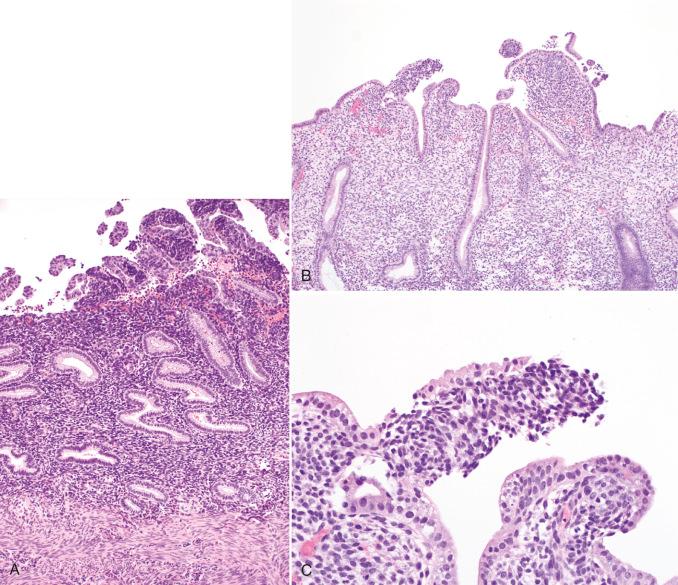
Proliferative phase endometrium reflects the influence of estrogenic hormones from the developing ovarian follicle, which stimulate gland proliferation and produce the classic tubular gland with pseudostratified epithelium and increased mitotic activity. At low power, the glands appear blue or dark because of the pseudostratified basophilic nuclei ( Fig. 16.6A ). The pathologist who examines these glands at high magnification may be initially concerned by the coarse-appearing nuclear chromatin and high mitotic index ( Fig. 16.6B ). The critical feature that aids in the recognition that these glands are benign is the orderly arrangement of the nuclei in an architecturally normal (i.e., round to minimally irregular) gland. As the cycle progresses, some edema may be seen followed by increased gland tortuosity prior to ovulation. Subclassification or assignment of a cycle day to these nuances of proliferative phase endometrium is not required inasmuch as they have no bearing on diagnosis and management. There are three diagnostic pitfalls in assessment of the proliferative phase. The first is the variable appearance of the stroma, which may include a prominent spindled appearance. The novice may sometimes misinterpret this feature as predecidua or progestin effect ( Fig. 16.6C ); however, the lack of prominent spiral arterioles and the presence of abundant mitoses are inconsistent with progestin effect. The second pitfall is intraluminal material misinterpreted as secretions. “Secretions” can be found in the lumen of any endometrial gland irrespective of cycle day and should not be used to assign a cycle date. A third pitfall is a technical one where gland tracts are susceptible to intussusception, also termed “telescoping” or “gland in gland” artifact ( Fig. 16.6D ). This may be misinterpreted as endometrial intraepithelial neoplasia (EIN); however, this pattern has been sufficiently well described that it should not be confused with neoplasia. The diagnosis we render for this phase of the cycle is simply “proliferative endometrium.”
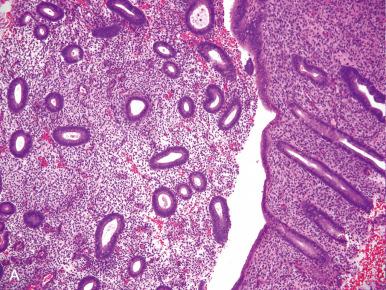
Ovulation as defined occurs on day 14 of the cycle. Both 15- and 16-day endometrium are technically synonymous with the first and second days following ovulation. Both may be characterized by the presence of subnuclear vacuoles in an endometrium that has the glandular architecture (and mitotic activity) of proliferative endometrium. These findings are subtle in day 15 and conspicuous in 16-day endometrium ( Fig. 16.7 ). The endometrial glands will appear slightly larger and slightly less basophilic at low power because of the interruption of the pseudostratified epithelium by vacuoles. Mitoses must be present but will be less conspicuous. The transition to a pattern that is diagnostic of ovulation (day 17 secretory phase) occurs when a discrete group of glands with no mitoses and uniform subnuclear vacuoles is identified. The reader is reminded that subnuclear vacuoles alone are not sufficient for a diagnosis of ovulation if mitoses are present. Thus, the diagnosis rendered for this pattern is “16-day endometrium. This pattern may be associated with ovulation; however, it is not specific for ovulation and may be seen with estrogen alone.”
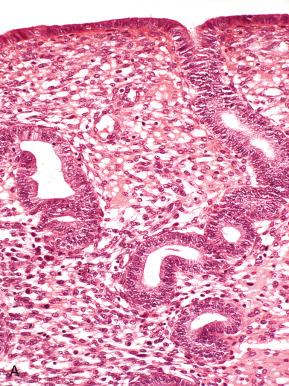
The vacuole phase of secretory endometrium signifies the first phase of the postovulatory period. The low-power appearance of the endometrium contains glands that are larger and slightly undulating and that appear more eosinophilic because of the absence of pseudostratified nuclei combined with vacuoles and intracellular secretions ( Fig. 16.8A ). As described earlier, 17-day secretory endometrium is characterized by uniform subnuclear vacuoles and virtually no mitotic activity ( Fig. 16.8A inset ). In 18-day secretory endometrium, the vacuoles are staggered toward the lumen and are accompanied by supranuclear discharge, seen as a ragged surface change ( Fig. 16.8B ). The vacuoles may or may not be conspicuous; however, the nuclei are prominently situated in the center of each cell, forming a uniform monolayer amidst eosinophilic cytoplasm. In day 19 secretory endometrium, the nuclei have nearly migrated back to the base and are accompanied by scattered residual subnuclear vacuoles and the appearance of early secretory exhaustion; mitotic activity typically is not present ( Fig. 16.8C ).
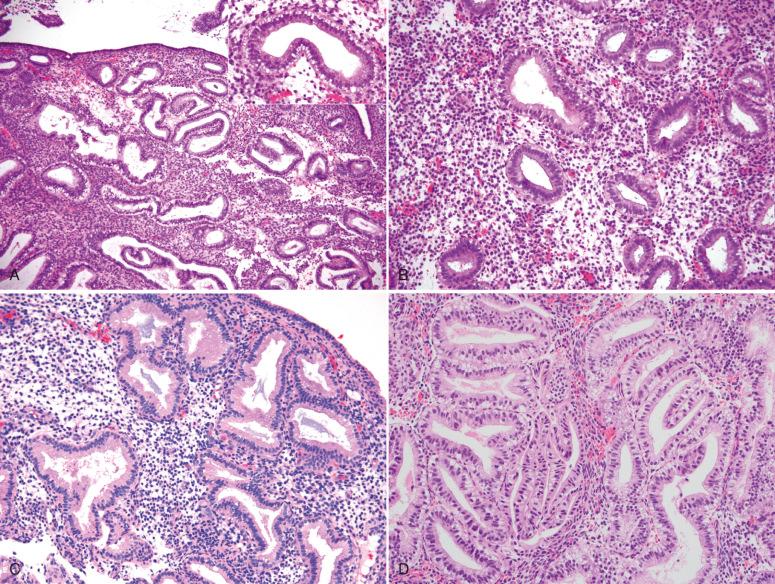
One diagnostic pitfall commonly encountered in the vacuole phase of the endometrial cycle is an irregular random pattern of gland enlargement leading to foci of gland crowding. This is sometimes erroneously interpreted as a “secretory hyperplasia” (secretory EIN) ( Fig. 16.8D ). In contrast to EIN, there is no appreciable cellular stratification, nuclear changes in comparison with the rest of the endometrium, or other features seen in early neoplasia.
Conclusion of the vacuole phase is characterized by secretory exhaustion. This pattern persists for the remainder of the cycle, with the exception of occasional hypersecretory changes that might accompany the late secretory phase. The early phases of this latter portion of the cycle are relatively indistinct. Secretory endometrium day 20 demonstrates peak intraluminal secretions accompanied by occasional residual subnuclear vacuoles combined with slight gland enlargement and a compact subsurface stroma ( Fig. 16.9A ). The presence of this subsurface change may be misinterpreted as stroma exhibiting predecidual change, leading to misinterpretation of the cycle day as day 25. However, the former does not display prominent perivascular cuffing and, unlike predecidua, the stromal cells still exhibit dark nuclei and scant cytoplasm. Secretory endometrium day 21 exhibits an increase in stromal edema, highlighting the spiral arterioles ( Fig. 16.9B ). Secretory endometrium day 22 is characterized by a peak in stromal edema and exhibits the first hint of perivascular cuffing, but conspicuous predecidual changes are lacking ( Fig. 16.10 ).
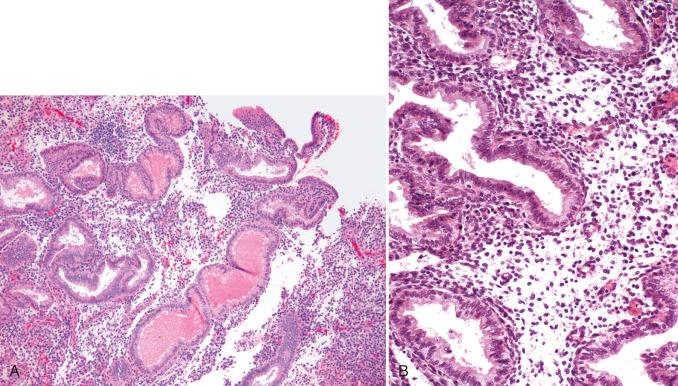
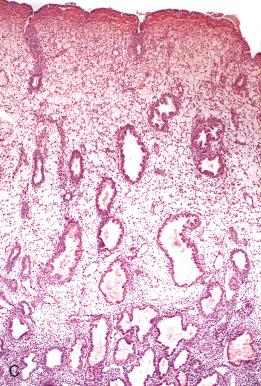
This phase is initiated by the condensation of predecidua around spiral arterioles. Predecidua is not actually decidua because it is not the result of pregnancy; nevertheless, the term predecidua is used because the cells bear some morphologic resemblance to pregnancy-related decidual change. Predecidua has three characteristics. The first is 1) spiral arterioles with spindled cells around vessels ( Fig. 16.11A ). A potential pitfall is the interpretation of larger arteries as spiral arterioles and confusing the two to three layers of investing adventitia around these larger arteries as predecidua. However, predecidua exhibits two additional distinctions, being 2) the acquisition of slightly basophilic (as opposed to eosinophilic) cytoplasm, often with distinct cell borders, and 3) nuclear changes that are characterized by a reduction in basophilia with finer chromatin texture. This combination of abundant darker cytoplasm mixed with paler nuclei reduces the nuclear/cytoplasmic contrast, making the cells less distinct and lending a slightly “smudged” or “out of focus” appearance to the aggregates. This relative “softness” amid the higher contrast of the lower functionalis distinguishes predecidua from its mimics ( Fig. 16.11B ). As a general rule, perivascular aggregates involving single vessels signifies day 23 ( Fig. 16.11A ), aggregates bridging multiple vessels are day 24, subsurface aggregates are present in day 25, linear sheets beneath the surface signify day 26 ( Fig. 16.12A ), and continuous subsurface with expansion downward between the folds of the functionalis are assigned day 27 ( Fig. 16.12B and C ). In mid to late secretory phase endometrium, adjacent glands may display a transition from dilated glands with a simple contour to those having a “saw-toothed” configuration ( Fig. 16.13A ); but in the late phase, the glands may be variably dilated or tubular (similar to the changes seen with progestin effect [ Fig. 16.13B ]). The prominent saw-toothed glands may be confused with pregnancy but are not diagnostic in the absence of the nuclear features characterizing Arias-Stella change (see Fig. 16.45 later in the chapter).

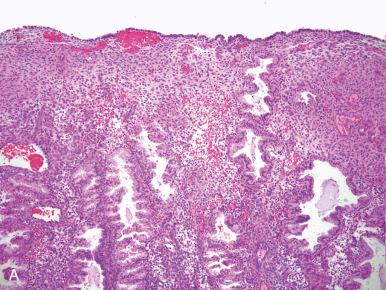
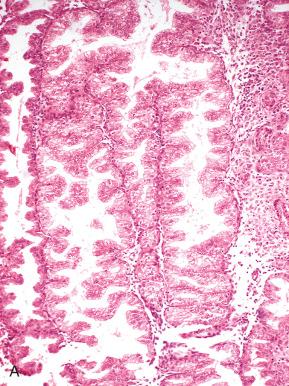
Scattered endometrial stromal granulocytes may be seen by secretory day 24 to 25 but are conspicuous by day 26 ( Fig. 16.12C ). One potential diagnostic pitfall is edematous predecidua, which may be confused with day 21, particularly by the inexperienced ( Fig. 16.14A ). Closer examination of the edematous areas will confirm the presence of cells with the characteristic basophilic cytoplasm and other features of individual predecidual cells as described earlier. In general, the spaces between the stromal cell nuclei in late secretory phase are occupied by cytoplasm, in contrast to earlier in the phase when the nuclei are separated by fluid ( Fig. 16.14B ). A second diagnostic pitfall is interpretation of stromal granulocytes as inflammation or chronic endometritis. However, in contrast to the latter, no plasma cells are present, and the setting of late secretory endometrium is inconsistent with chronic endometritis. The diagnosis for secretory endometria is simply “secretory endometrium (day specified).”
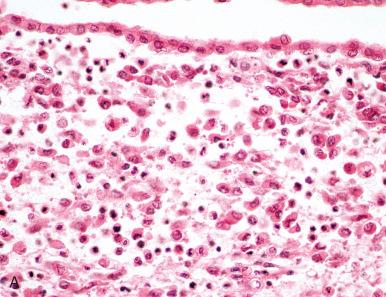
The endometrium plays an obvious and critical role in human reproduction. Without implantation of the early embryo and its development within the uterus, reproduction is impossible. Therefore, assessment of endometrial function through the endometrial biopsy has been a mainstay of the fertility evaluation. Evidence of its primacy in the historical infertility evaluation is demonstrated by the classic study on endometrial dating by Noyes et al. This sentinel paper was the first article in the first issue of Fertility and Sterility. In contemporary practice, however, the use of the endometrial biopsy in the assessment of the infertile female is much more limited. In fact, the possible role of the endometrial biopsy in infertility management is relegated to four areas: (1) confirmation of ovulation, (2) assessment of the luteal phase, (3) recurrent implantation failure and chronic endometritis, and (4) preparatory cycles in patients undergoing egg donation. As is demonstrated in the subsequent sections, however, the evidence does not support its use even in these limited circumstances.
The change from proliferative endometrium to secretory endometrium can only occur when ovulation has taken place. The basic pathologic criteria for the secretory phase have been already reviewed, but they are not substantially different from those reported by Noyes et al. more than a half century ago. By day 16 of a textbook, 28-day cycle, subnuclear vacuoles of the glandular epithelium are seen; and by the next day, the nuclei line up with cytoplasm above and vacuoles below. Thus one can confirm ovulation by an endometrial biopsy demonstrating secretory endometrium. Today, however, there are modalities to more easily document ovulation. A mid-luteal progesterone level 3 ng/mL or higher is sufficient to identify ovulation, although the timing of ovulation in relation to the blood draw is uncertain. Serial transvaginal ultrasound can document the expansion of the antral follicle with subsequent collapse of the follicle and the typical findings of internal echoes within the corpus luteum following ovulation. An alternative approach is to have the patient use an over-the-counter ovulation prediction kit. The start of the LH surge, detectable in the urine, precedes ovulation by approximately 36 hours. Thus a positive LH surge in the urine is presumptive evidence of ovulation with a high degree of accuracy. A final option is for the patient to chart her early morning basal body temperature. Progesterone, secreted by the corpus luteum, is a thermogenic hormone, which raises body temperature by approximately 0.5° F. This rise in basal temperature is presumptive evidence of ovulation. Although simple in principle, basal body temperature charting is difficult in practice, because it requires the woman to take and record her temperature daily upon awakening and before she leaves bed.
Luteal phase defect (LPD) or sometimes termed inadequate luteal phase is defined as secretory maturation that is at least 2 days earlier than the expected chronological dating in two, preferably consecutive, cycles. In the past decade, the endometrial biopsy as a tool to access the adequacy of the luteal phase has come under fire. Those opposed to its inclusion in the workup of the infertile couple offer several reasons for its demise. First, the dating of the endometrium can vary from cycle to cycle. Davis et al. examined consecutive biopsies in five menstruating women with proven fertility. Using a 2-day or greater lag in endometrial maturity to define LPD, the incidence of a single and sequential out-of-phase endometrial biopsies was 51.4% and 26.7%, respectively. Using a 3-day or greater log to define LPD, the incidence of single and sequential out-of-phase biopsies was 41.4% and 6.6%, respectively. Thus the authors demonstrated the cycle-to-cycle variability of endometrial dating. Furthermore because a very high incidence of LPD was found in known fertile women, the authors questioned the standard criteria for defining LPD.
A second problem in the utilization of LPD as a diagnostic tool in the infertility evaluation concerns the inter- and intra-observer variability seen in dating the endometrium. In one study, five observers twice analyzed split endometrial biopsies from 25 women. A total of 65% and 27% of discrepancies, respectively, were explained by inter- and intra-observer varability. In a study that evaluated 774 endometrial biopsies performed for infertility, Davidson et al. found a luteal phase lag of more than 2 days in 19% of biopsies, but an LPD was only diagnosed in 5.7%. The authors concluded that most of the incidence of LPD could be predicted by chance alone. Duggan et al. assigned 78 endometrial biopsies to a panel of four pathologists. Each pathologist read the biopsies twice, once using “usual practice” and a second time after studying a document defining the histologic criteria. On the initial review, 68% of biopsies were dated within 1 day of each other, and 77% were dated within 2 days with no improvement on re-review. In a well-executed study, Murray et al. accessed the reproducibility of histologic endometrial dating across the menstrual cycle in fertile women with the phase of the cycle confirmed by serum estradiol and progesterone measurements. For mid and late luteal phase biopsies, the agreement among the panel of the pathologists was 79% for normal and 81% for biopsies judged delayed according to a scoring system using 32 histologic criteria. Thus, even in the most favorable of studies, the inter-observer variability exceeds 20%, calling into question the accuracy of the diagnosis of LPD.
A third issue concerns the prevalence of LPD in infertile women as compared to fertile controls. In a well-designed and well-executed study from the National Cooperative Reproductive Medicine Network, Coutifaris et al. evaluated 619 mid and late luteal biopsies from fertile women and women from infertile couples. There were no differences in the percentage of out-of-phase biopsies using 2 days, 3 days, and 4 days out of phase on either mid-luteal or late-luteal biopsies. Luteal phase dating was based on the urinary LH surge. For example, biopsies determined to be 3 or more days out of phase using biopsies on cycle days 22 and 23 were 49.4% in fertile women and 43.2% in infertile women ( p = 0.33), respectively. In fact, the percentage of out-of-phase biopsies was higher among fertile women for each of the out-of-phase definitions used and for both of the biopsy time periods. The authors concluded that “histologic dating of the endometrium does not discriminate between women in fertile and infertile couples and should not be used in the routine evaluation of infertility.”
Consequently, the Practice Committee of the American Society for Reproductive Medicine (ASRM) concluded that “histologic endometrial dating is not a valid diagnostic method because it lacks both accuracy and precision and because the test cannot distinguish fertile from infertile women. Therefore endometrial biopsy is no longer recommended for the evaluation of ovulation or luteal function in infertile women and should be limited to those in whom specific endometrial pathology (e.g., neoplasia, chronic endometritis) is strongly suspected.”
Finally in a Committee Opinion titled, “Current Clinical Irrelevance of Luteal Phase Deficiency: A Committee Opinion,” the Practice Committee of the ASRM further stated, “currently there is no reproducible, pathophysiologically relevant and clinically practical standard to diagnose LPD and distinguish fertile from infertile women.” The opinion concluded, “Although progesterone is important for the process of implantation and early embryonic development, LPD as an independent entity causing infertility has not been proven.”
A vexing problem in the clinical application of in vitro fertilization (IVF) is the patient with repeated implantation failure despite multiple embryo transfers of good quality embryos. One putative etiological factor proposed to account for this condition is chronic endometritis. Its diagnosis is based on the identification of plasma cells within the endometrium, usually obtained via endometrial biopsy. Some, however, have suggested that chronic endometritis can be diagnosed by hysteroscopy based on a constellation of findings including micro-polyps, stromal edema, and focal or diffuse hyperemia. Kasius et al. examined 678 asymptomatic infertile women with a normal transvaginal ultrasound who underwent hysteroscopy prior to their initial IVF cycle. The prevalence of chronic endometritis in patients with an adequate endometrial biopsy was 2.8%. The cumulative birth rate was 76% in patients with endometritis and 54% in those without ( p > 0.05). This result implied that endometritis is not associated with infertility, but the relevance of the finding was somewhat mitigated, however, because patients at one of the two clinical sites in Belgium were given antiobiotic therapy to treat the endometritis at the discretion of the treating gynecologist, whereas those treated at the other center were not offered treatment. In either case, however, the diagnosis of endometritis did not appear to adversely affect outcome.
A different result was seen by Cincinelli et al., who retrospectively examined the IVF outcome of 106 women with unexplained infertility and recurrent implantation failure. Of these women, 66% were diagnosed with chronic endometritis at hysteroscopy. Of these subjects, 87% had chronic endometritis confirmed by histology, and 69% had the disease confirmed by culture. All patients were treated with antibiotics. The authors compared the IVF outcome in those successfully treated, as determined by criteria at hysteroscopy and those in whom the treatment failed. The live birth rate was higher in the successfully treated group, 60.8% versus 13.3% ( p = 0.02). The study's conclusions were limited by the lack of a pathologic diagnosis in some of the affected individuals, and the lack of histologic confirmation of the success of antibiotic treatment. A different approach was taken by a group in the United States. Johnston-MacAnanny et al. evaluated the outcome of 33 patients with recent implantation failure who underwent endometrial biopsy compared to 485 patients with recurrent implantation failure who did not have a biopsy. Only 10 of the 33 patients had chronic endometritis on biopsy. There was no significant difference in pregnancy rates or live births among patients with chronic endometritis on biopsy, those without endometritis on biopsy, and those without endometrial sampling. The study's conclusions were limited by the small sample size in the biopsy groups.
The inter-observer variability of the histologic diagnosis of endometritis has also been assessed. The slides from the study of Kasius et al. were reviewed by two pathologists using hematoxylin and eosin (H&E) stain and, if the diagnosis was uncertain, a battery of additional immunohistochemical markers for plasma cells and β-lymphocytes. Perfect agreement between the two pathologists was seen in 88% of the H&E cases and 86% of cases with the added immunohistochemistry staining.
In summary, there is little evidence that chronic endometritis is a frequent finding in patients with unexplained implantation failure; however, the reason for the wide variation in the reported prevalence of the condition remains unclear. Furthermore, even in cases of histologically proven endometritis, antibiotic treatment does not appear to affect outcome. Finally, although pathologic agreement on the diagnosis of chronic endometritis is good, it is far from unanimous.
A final potential use of the endometrial biopsy in infertile patients occurs in the setting of endometrial preparation cycles in ovum donation recipients. Some fertility specialists utilize a “mock” cycle using estrogen and progesterone in recipients in IVF cycles in which donor eggs will be used. In these cycles, an endometrial biopsy is used to evaluate the “adequacy” of the hormones used by demonstrating sufficient luteal progression as assessed by at least a day 23 endometrium according to the criteria of Noyes et al. Jun et al. from Brigham and Women's Hospital retrospectively analyzed the records of 98 egg donation recipients undergoing their first egg donation cycle. Preparatory cycles were performed in 50 patients, and preparatory cycles were not performed in 48 patients according to physician preference. There was no statistically significant difference in pregnancy rates in women with and without preparatory cycles, 42.0% versus 43.8% ( p > 0.05). Furthermore, among patients who underwent preparatory cycles, the percentage of adequate endometrial biopsies did not differ between the subsequently pregnant and non-pregnant patients, 76.2% versus 84.3% ( p > 0.05), respectively. Although retrospective, these results do not provide support for the use of endometrial biopsies to assess the adequacy of the luteal phase in preparatory cycles in ovum donation recipients.
There is little role for the assessment of the endometrium in infertile women. Although the endometrial biopsy can provide definitive evidence of ovulation, it can do so only in the cycle biopsied. In addition, there are simpler, more cost-effective and less uncomfortable ways to evaluate the ovulatory status of the infertile woman. Work in recent years has provided sufficient evidence that the assessment of the luteal phase adds little to the fertility evaluation. In fact, there is no evidence that a luteal phase deficiency even exists as a cause for infertility. The ASRM advises against endometrial biopsies for the purpose of determining a putative LPD. The role of the endometrial biopsy in the evaluation of patients with recurrent implantation failure in IVF has also been questioned. There is a paucity of data to support its use for this indication. Lastly, although based on limited evidence, there seems to be no need to biopsy the endometrium in recipients in egg donation cycles.
Another area in which the endometrial biopsy has traditionally been used is in the assessment of the woman with recurrent pregnancy loss. The utility of the biopsy is predicated on the requirement for progesterone synthesis by the corpus luteum to sustain an early pregnancy until 8 to 12 weeks of gestation. Absent adequate progesterone support, the early pregnancy is destined to fail, leading to miscarriage. The endometrial biopsy has been used in this context as a tool in the assessment of the adequacy of progesterone on the end organ of interest—the endometrium. If the dating of the endometrium lagged behind its chronological counterpart, the theory was that there was an LPD and a potential cause for miscarriage. For many years, this reasoning proved attractive in theory but was later shown to be dubious in practice.
Recently, several investigators have utilized supplemental progesterone to support the early pregnancy in women with a history of unexplained pregnancy loss. A Cochrane review of four studies showed benefit in terms of a lower risk of miscarriages in women who received progesterone supplementation compared to placebo or no progesterone (odds ratio [OR] 0.39; 95% confidence interval [CI], 0.21–0.72). A large multicenter prospective, randomized placebo-controlled trial involving 1568 women with unexplained recurrent pregnancy loss randomized subjects to progesterone vaginal suppositories or placebo beginning with a positive pregnancy test and continuing through 12 weeks’ gestation. The live birth rate was 65.8% in the progesterone group and 63.3% in the placebo group (relative risk [RR] 1.04; 95% CI, 0.94–1.15), indicating a lack of benefit of progesterone treatment. One possible limitation in this study, however, is that progesterone was started roughly a week after implantation, which was too late, some might argue, to improve implantation. Nonetheless, this study's strengths included its size, entry criteria, and design. Without a proven benefit of progesterone support, it is difficult to establish a reason to biopsy the endometrium for an LPD in patients with recurrent pregnancy loss.
These studies and others demonstrating limited reproductivity of endometrial dating and the lack of correlation with infertility have led the ASRM to state that, “Histologic endometrial dating was widely accepted for decades as the gold standard among methods for assessing the quality of luteal function but more recently has been proven invalid.” Furthermore in its Practice Committee Opinion, “Evaluation and Treatment of Recurrent Pregnancy Loss: A Committee's Opinion,” the ASRM stated, “Therefore, routine endometrial biopsy for dating is not recommended, although continued research on the emerging molecular markers of endometrial development should be encouraged.”
In summary, the existing data do not support the routine use of the endometrial biopsy to diagnose an LPD as part of the evaluation of the couple with recurrent pregnancy loss.
AUB is defined by the American Congress of Obstetricians and Gynecologists (ACOG) as menstrual flow outside of normal volume, duration, regularity, or frequency. Normal menstrual volume is 80 mL or less per cycle; however, such an amount is difficult for patients and clinicians to determine with confidence. The normal duration of menses is 5 days, and a normal cycle lasts between 21 and 35 days with cycles more frequent than every 21 constituting polymenorrhea and cycles less frequent than every 35 days as oligomenorrhea. It has been estimated that more than 70% of gynecologic consultations are for AUB and that AUB accounts for one-third of ambulatory gynecologic visits.
As summarized by Ferenczy, cyclic (menstrual) bleeding takes place in the upper two-thirds of the endometrium; is initiated by the release of proteolytic enzymes of endometrial and leukocyte origin; and is characterized by tissue necrosis, loss of vascular integrity, inflammatory cell infiltrates, and thrombi in small vessels. Moreover, cyclic bleeding occurs in a diffuse (programmed) manner. Abnormal bleeding tends to localize to the upper third of the functionalis, where it may be focal or diffuse. The breakdown is mediated by inflammatory (endometritis) or vascular (fragility) phenomena, which may accompany chronic endometritis, polyps, submucosal leiomyomata, atrophy, and other organic causes. Similarly, alterations in vasculature that predispose to bleeding may be found in altered hormonal environments, including anovulation and progestational hormonal therapy. In the absence of a morphologic abnormality, impaired vasoconstriction and fibrinolysis are presumed to be the mechanisms accounting for endometrial bleeding.
The evaluation of uterine bleeding has long suffered from a lack of universally accepted definitions and terminology. In an effort to address these problems and move toward a universally accepted system to describe the range of conditions associated with AUB, the International Federation of Gynecology and Obstetrics (FIGO) introduced a new classification system, PALM-COEIN in 2011. ACOG adopted the classification system in 2012, and its Practice Bulletin, “Diagnosis of Abnormal Uterine Bleeding in Reproductive-Aged Women,” offers an excellent contemporary overview of the subject with a balanced assessment of some of the controversies surrounding the diagnosis and treatment of AUB.
The PALM-COEIN classification (see Fig. 16.1 ) divides etiologies of AUB into structural causes (PALM) and nonstructural causes (COEIN). The acronym PALM includes:
P olyps (AUB-P)
A denomyosis (AUB-A)
L eiomyoma (AUB-L)
M alignancy and hyperplasia (AUB-M)
COEIN includes:
C oagulopathy (AUB-C)
O vulatory dysfunction (AUB-O)
E ndometrial (AUB-E)
I atrogenic (AUB-I)
N ot yet classified (AUB-N)
It should be noted that the term dysfunctional uterine bleeding (DUB), which has been defined as AUB without demonstrable organic cause, has been eliminated in the current nomenclature. The etiology of DUB usually refers to bleeding abnormalities associated with oligo-ovulation or anovulation. In the PALM-COEIN system, it falls in the category of ovulatory dysfunction (AUB-O). Definitions notwithstanding, in clinical practice DUB is frequently listed on the pathology requisition. In this setting, DUB is not specific and is essentially synonymous with abnormal bleeding.
The clinician should take a complete history inquiring in detail about bleeding patterns, length, interval, and quantity of bleeding, as well as associated symptoms, such as pain. A list of medications, possibly including herbal preparations, is important. The physical examination should emphasize findings that may suggest the etiology and an underlying endocrine disorder, such as thyroid disease or polycystic ovary syndrome (PCOS), or a coagulopathy. A thorough pelvic examination including speculum examination looking for vaginal or cervical lesions (looking for an underlying malignancy or polyps) and bimanual examination (to detect possible uterine fibroids, adenomyosis, or malignancy) must be performed.
Structural causes of AUB—polyps, adenomyosis, and leiomyomata (fibroids)—are best diagnosed by an imaging technique or direct visualization via hysteroscopy. Transvaginal ultrasonography is an excellent technique to evaluate the myometrium for fibroids; however, its sensitivity for detecting endometrial lesions is low. Better modalities to detect intra-cavitary lesions (such as, polyps or submucosal fibroids) include the hysterosalpingogram (HSG), sonohysterogram, and hysteroscopy. Kelekci et al. compared the diagnostic accuracy and acceptability of transvaginal ultrasound, sonohysterogram, and office hysteroscopy in detecting intracavity abnormalities in women with and without AUB. The sensitivity and specificity of transvaginal ultrasound, sonohysterogram, and office hysteroscopy were 56%, 72%, and 81%, and 100%, 88%, and 100%, respectively, with the definitive diagnosis made at hysterectomy. Sonohysterograms were better tolerated than office hysteroscopies, and the addition of color Doppler may improve the diagnostic accuracy of ultrasound to detect intracavity lesions.
The diagnosis of adenomyosis can only be made definitively by pathology from a hysterectomy specimen. Historically, adenomyosis has best been inferred by the findings on magnetic resonance imaging (MRI). However, in recent years, improvements in the resolution of transvaginal ultrasound have allowed the diagnosis to be made via sonography based on a combination of findings, including a hysterogenous myometrium, myometrial cysts, and subendometrial linear striations. One prospective study found that a regularly enlarged uterus with a globular appearance, subendometrial echogenic linear striations, and myometrial cysts had the highest accuracy for diagnosing adenomyosis via ultrasound, but the presence of subendometrial striations was the most specific finding. A small study involving only 20 women with suspected adenomyosis found a higher false-negative rate with transvaginal sonography compared with MRI. Bromley et al. found that a mottled heterogenous appearing uterus was most accurate for detecting adenomyosis. There is dispute regarding the superiority of MRI or transvaginal ultrasound in the diagnosis of adenomyosis. A large meta-analysis involving 14 studies and 1895 aggregate participants, however, found that transvaginal ultrasound had 83% sensitivity and 85% specificity for the diagnosis of adenomyosis prior to hysterectomy. The authors concluded that transvaginal ultrasound is an accurate test for adenomyosis. Two other studies concluded that the two techniques have similar diagnostic accuracy, but transvaginal ultrasound may be a more difficult technique to master and may be more operator-dependent.
The most critical role of the gynecologist in the evaluation of AUB is to rule out malignancy. Although strictly not a cause of AUB, cervical causes of bleeding should be accessed via cervical cancer screening (Papanicolaou [Pap] smear) and an evaluation for cervicitis ( Neisseria gonorrhoeae and Chlamydia trachomatis testing) if indicated (ACOG recommendation). Endometrial sampling is indicated in all women with AUB older than 45 years old. Women younger than 45 years old should have endometrial sampling in situations in which unopposed estrogen exposure is likely, such as PCOS, obesity, failed medical management, or in situations in which the abnormal bleeding is persistent. Specialized situations (such as, tamoxifen therapy or Lynch syndrome) also warrant endometrial assessment.
The initial evaluation of the endometrium should be, in almost all cases, an office-based endometrial biopsy. A variety of aspiration devices exist; however, a large meta-analysis found that use of the Pipelle device was more sensitive than other devices. Its sensitivity in pre-menopausal women for the diagnosis of endometrial cancer was 91% and for atypical endometrial hyperplasia, 81% with specificity for the diagnosis of endometrial cancer approaching 100%.
One limitation of the endometrial biopsy is that it is more likely to miss a focal lesion. This is particularly true if the lesion occupies less than 50% of the endometrial cavity. A recent study comparing Pipelle and diagnostic curettage in 130 women in the setting of AUB in patients over age 35 found agreement according to pathology results in 94% of cases and 100% of cancer diagnoses. In certain circumstances, a dilatation and curettage under anesthesia in the operating room may be indicated, including the inability to tolerate an in-office biopsy, inability to obtain an adequate sample, or a non-diagnostic biopsy. A full curettage may also be necessary in women with benign pathology with persistent bleeding or bleeding unresponsive to treatment. In postmenopausal women, a transvaginal ultrasound demonstrating an endometrial thickness of 4 mm or less is associated with a very low risk of malignancy and may be used for initial evaluation. In a study involving 339 women with an endometrial thickness of 4 mm or less, none was diagnosed with endometrial cancer on endometrial biopsy. In a cohort of 4383 women with postmenopausal bleeding, 3.8% were diagnosed with endometrial cancer. The sensitivity and specificity of a 4-mm endometrial thickness cut-off were 94.1% and 66.8%, respectively. A large meta-analysis of 35 studies yielded a sensitivity of 96% for the detection of endometrial cancer with a threshold of 4 mm in postmenopausal women presenting with bleeding. Ultrasound is significantly less helpful in pre-menopausal and perimenopausal women. Transvaginal ultrasound assessment of endometrial thickness, however, is not sufficient to rule out malignancy in pre-menopausal women. A large retrospective study including 14,340 ultrasounds in 9888 women found endometrial abnormalities in 162 women. A thickened endometrium alone without other abnormalities of the endometrial stripe was not associated with precancerous lesions of the endometrium.
The role of hysteroscopy in the diagnosis of endometrial malignancies and pre-malignancies is controversial. Because hysteroscopy without biopsy may miss a high percentage of cancers, hysteroscopy should be used only in concert with endometrial sampling. Hysteroscopy does afford the opportunity to observe other pathology, however, such as endometrial polyps and submucous fibroids.
The nonstructural causes of abnormal bleeding include: coagulopathy (AUB-C), ovulatory dysfunction (AUB-O), endometrial (AUB-E), iatrogenic (AUB-I), and not yet classified (AUB-N).
Coagulopathies (AUB-C) include a group of inherited bleeding disorders that may play a prominent role in abnormal bleeding, and those fulfilling strict criteria (such as, by a pictorial bleeding assessment chart) constituted 16% of women presenting with menorrhagia in one study. Some 60% to 74% of women with von Willebrand disease and factors XI and VII deficiency present with menorrhagia.
Ovulatory dysfunction (AUB-O) refers to a group of oligo-ovulatory or ovulatory disorders leading to abnormal bleeding. Most common among these is PCOS, which is an ovulatory disorder associated with hyperandrogenism. As previously discussed, this condition may be associated with unopposed estrogens putting the patient at risk for endometrial hyperplasia. Other endocrine causes of abnormal bleeding include hyper- or hypothyroidism, hyperprolactinemia, and hypothalamic amenorrhea.
Three general patterns may be included under the heading of AUB—ovulatory dysfunction. The first is a visible change (cystic) in the endometrial glands for which a presumptive diagnosis of anovulation can be made. In a study of 1282 cases of dysfunctional bleeding, 77% were attributed to anovulation and, of these, 89% to persistent follicle or other glandular disturbance (“hyperplasia”). This pattern may be classified as “estrogen breakthrough bleeding.” The second is a proliferative-pattern endometrium with subnormal proliferation, which could signify subnormal estrogen stimulation or a disturbance in folliculogenesis (or a failed follicle). This group comprised approximately 11% in the study by Vakiani et al. and may be loosely termed “estrogen withdrawal bleeding.” Other patterns include the finding of ovulatory endometrium with disturbances in the follicular (prolonged) or luteal phase or in premenopausal patients, impaired vasoconstriction, and coagulation disturbances.
Endometrial (AUB-E) etiologies include a group conditions in which bleeding tends to be heavy or prolonged but occurs within the setting of normal ovulatory cycles. Munro et al., in their summary of the FIGO classification of abdominal uterine bleeding, offer several examples of endometrial causes of AUB. The disorders may include localized abnormalities within the endometrium itself, such as deficiencies in endometrial vasoconstrictors like endothelial-1 and prostaglandin F2-alpha or plasminogen activator. Increased production of vasodilators, such as prostaglandin E 2 or prostacyclin I 2 , may also play a role. On a practical basis, these conditions are diagnoses of exclusion, because there are no clinically available diagnostic tests to make these diagnoses.
Iatrogenic causes (AUB-I) include hormonal preparations (such as, estrogen-progesterone contraceptives), the levonorgestrel releasing intrauterine device (IUD), and non-hormonal medications (such as, warfarin, heparin, non-steroidal antiinflammatory drugs [NSAIDs], and drugs that interfere with dopamine metabolism). Lastly, some causes of AUB remain not classified (AUB-N). These disorders are poorly defined and rare. Examples include arteriovenous malformations and myometrial hypertrophy.
The diagnostic evaluation of the patient with AUB should begin with a thorough history and physical examination. The initial laboratory evaluation should include a complete blood count (CBC) and, in reproductive age women, a reliable pregnancy test. A reasonable workup to rule out anatomic causes (polyps, leiomyomata, and adenomyosis) should start with a transvaginal ultrasound. The initial test to rule out malignancy is the endometrial biopsy. The diagnostic evaluation for nonstructural causes (coagulopathy, ovulatory disorders, endometrial, and iatrogenic) depends on the history and physical examination. In cases in which a coagulopathy is suspected, prothrombin time, partial thromboplastin time, and fibrinogen constitute a reasonable screen. Because von Willebrand disease occurs in 11% to 16% of women presenting with menorrhagia, a laboratory screen for this condition also seems reasonable.
A thyroid-stimulating hormone (TSH) level should be assessed in all women in whom an ovulatory disorder is suspected. More extensive thyroid testing may be performed as necessary. Specific evaluation for other causes of oligo-ovulation or anovulation (such as, hyperprolactinemia or PCOS) may be performed according to the history and physical examination. Serum prolactin (hyperprolactinemia), testosterone, dihydroepiandrosterone-sulfate, sex hormone binding globulin (SHBG), and 17-hydroxyprogesterone may be ordered as indicated. Additional testing may be ordered as needed as the evaluation progresses.
Become a Clinical Tree membership for Full access and enjoy Unlimited articles
If you are a member. Log in here